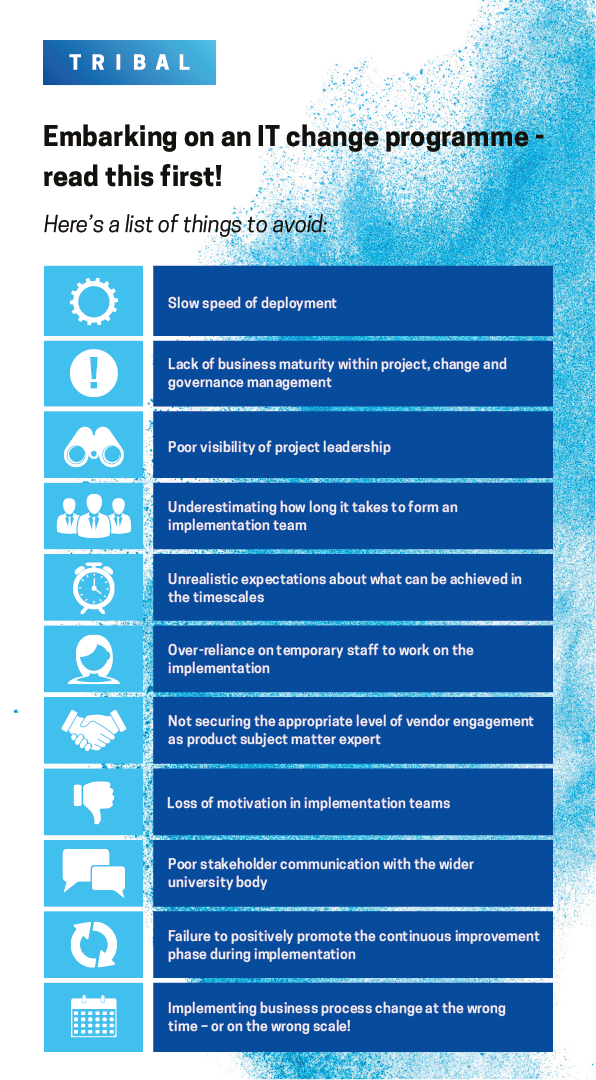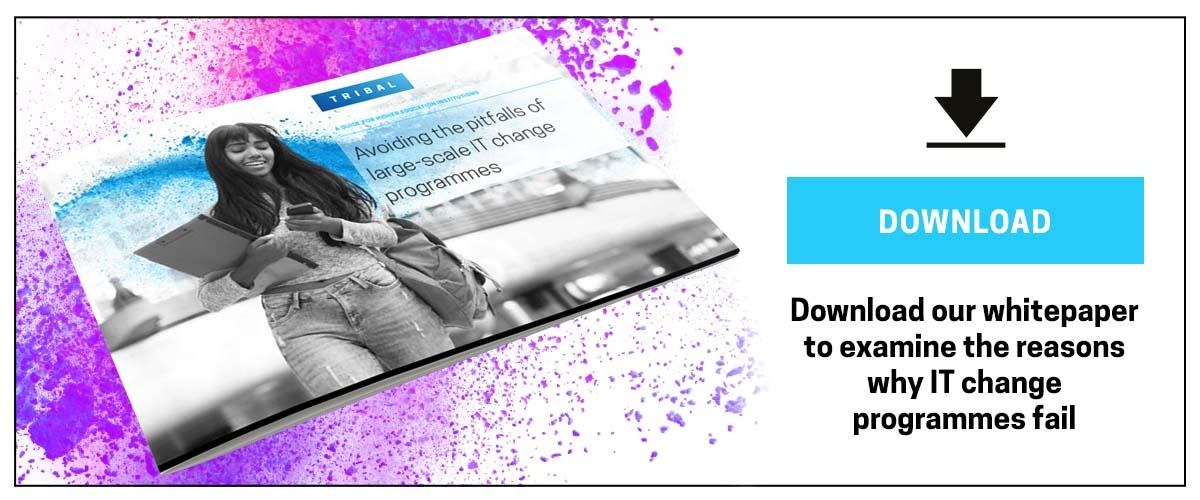Large-scale IT change programmes are notoriously complex to implement, and all too often fall short of project goals. To deliver the agreed scope on time and within budget takes experienced project management expertise, and ensuring the business is willing to change to reach the strategic outcomes of the project takes active project sponsorship. But these aren’t the only challenges.
Here are the most common reasons why IT change programmes fail – and our top tips for overcoming them:
Slow speed of deployment
- Particularly in business environments that are changing constantly – ‘speed of execution’ is increasingly more important than ‘perfect execution’. Delaying ‘go live’ to perfect a solution runs the risk of it being rendered irrelevant by the time it’s implemented. So aim to make it ‘good enough’, deploy it, and then improve it based on feedback.
- “Fail-fast” – you might not get it right the first time but be prepared to learn from that and implement the necessary changes to prevent it happening again.
Lack of business maturity within project, change and governance management.
- Bring in specialist expertise to match the scale of the implementation and leverage, leverage, leverage your solution partner!
- Acknowledge the importance of change management and ensure it has a visible role in the project.
- Cover yourself with good risk and issue management strategies.
- Set up governance structures that mitigate risk and empower staff to make decisions in a timely way – this ladder up management needs to be lean and agile! (You can't wait till a Friday meeting if your project is running at 250k per week.)
Poor visibility of project leadership.
- Leaders need to be the face of change and to take the lead on communications to employees and managers.
- Building a coalition of sponsorship with peers and managers means leaders are seen to have a strong and active role in the project.
Underestimating how long it takes to form an implementation team.
- It is vital to understand the critical project roles and when in the project they need to come on board.
- Acknowledge how long it takes to get up to speed – team members may be new to Agile project management, learning new terminology and system tools will take time before they are operating at optimum velocity.
Unrealistic expectations about what can be achieved in the timescales.
- Work to the concept of a minimum viable product. Make sure your scope is deliverable and move things to continuous improvement if they cannot be met - and DOCUMENT that.
- Leverage the knowledge of your vendors Implementation Lead to identify an achievable scope and to plan workstreams and resources.
Over-reliance on temporary staff to work on the implementation.
- Too great a dependence on third parties for critical roles such as making key business decisions and team leadership means that once the project is over - you lose that knowledge. Invest in enabling full time staff to work on the implementation.
Not securing the appropriate level of vendor engagement as product subject matter expert.
- Ensuring you have relevant expertise available from the outset of the project helps to establish a customer-vendor relationship that will extend past Go Live and into BAU phases.
Loss of motivation in implementation teams.
- Sometimes your project team can feel demotivated if you’re only focussed on the big final go live….The key to keeping your implementation team motivated is to establish and celebrate project milestones - congratulate the project team on small wins and for meeting deadlines.
Poor stakeholder communication with the wider university body
- At all costs, avoid working in a bubble/silo. Whilst this may be attractive, you need the support and involvement of the business.
Failure to positively promote the continuous improvement phase during implementation.
- Make sure your Stakeholders understand that if they don’t get their requirements in first time, they will get them during the ‘Learn and Improve’ phase.
Implementing business process change at the wrong time - or on the wrong scale!
- Forgetting about business process change whilst focusing on software change can leave business users confused. Similarly, in the focus on getting a MVP solution across the line it can feel like there are missed opportunities to reengineer existing processes and make more transformative change. However, projects that attempt to undertake transformational change at the same time as the implementation of a new software solution are rarely successful. Therefore, a delivery approach that allows for a distinct ‘Learn and Improve’ phase is proven to be a safer and more successful incremental journey for business users.
If you’re embarking on an IT change programme and would like further tips and advice on how to ensure its success - read the next blog in this series: Ensuring success: Insights into rapid software implementations.

TOPICS:
SHARE THIS ARTICLE:



